Hike leader John Villella identifies macrolichens, such as Letharia vulpina, a species of "wolf lichen." E Thompson photo.
with John Villella, August 3-4, 2018
You may not know it, but you are surrounded by unsung heroes of the natural world. They inhabit twigs, trunks, rocks, soil, and even city sidewalks. Right beneath our feet, bryophytes and lichens are hard at work performing numerous ecosystem functions with little or no recognition at all. During our latest Hike & Learn, botanist and lichenologist John Villella helped us take a glimpse into the tiny world of these fascinating organisms.
On Friday August 3, John walked us through the basics of bryophyte and lichen biology. Bryophytes, including the liverworts, hornworts, and mosses, are spore-producing plants with no vascular tissue. More than 500 million years ago, bryophytes became the first plants to colonize land. Lichens are a bit more complicated. A lichen consists of a fungal partner and an algal partner living together in a mutually beneficial relationship. Essentially, the fungus provides a place for the algae to live and the algae provides “food” for the fungus through photosynthesis. Lichen can come in many shapes and colors, some subtle and hard to notice, others vibrant and other-worldly. A good rule of thumb: if it looks like it was made by Dr. Seuss, it is probably a lichen.
During our Saturday morning hike to Pilot Rock, we learned about the many ways that bryophytes and lichens benefit our ecosystem. When we see macrolichens such as the hairy-looking Usnea and Bryoria coating the branches of trees in the forest, it is easy to assume that the lichen is a parasite. It turns out that the exact opposite is true. Lichens do not steal nutrients from their substrates. Instead, their bodies absorb water from the air, creating a humid microclimate that helps trees obtain the moisture they need. When it rains, these lichens slow the flow of water down the trunk of the tree, which prevents soil erosion around the roots.
Mosses and lichens also provide habitat for microorganisms and invertebrates, which in turn form the base of a food web that supports larger organisms like birds and mammals. Moreover, lichens create habitat for plants on rocky substrates by breaking down rocks through the process of chemical weathering. Once larger plants are able to gain a foothold, their roots further break down the rock and slowly create soil.
One of the themes that emerged as we learned about lichens was their acute ability to survive. Lichens are not only incredibly long-lived (some are thousands of years old), but they can withstand incredible catastrophe. Wildfire, glacial events, and even the vacuum of space are no match for many lichens. These bizarre organisms can be found in every corner of the planet, even in the most desolate places. For instance, Antarctica, home to only 2 or 3 species of vascular plants, houses hundreds of species of bryophytes and lichens. These organisms are often the first to become established after environmental disturbances like fire or landslides, and pave the way for recolonization by other plants and animals.
As we arrived at the base of Pilot Rock and peered up into the smoke, we saw the rock formation in a whole new light. Pilot Rock is not only a popular landmark and a huge volcanic plug - it also habitat for dozens if not hundreds of species of lichens. Taking a closer look, we were scarcely able to find a single square inch of bare rock. Here, the lichens compete for real estate fiercely, if not extremely slowly. Who knows how many seasons they have seen, how many disasters they’ve endured, or how much longer it will take them to transform Pilot Rock into soil. These organisms, though small and easy to miss, hold the power to shape landscapes and form the foundation of ecosystems. Who knew all of that excitement was happening right beneath our feet!
by Heather Wilson
Hike and Learn Coordinator
Photos by Heather Wilson, except where noted.







